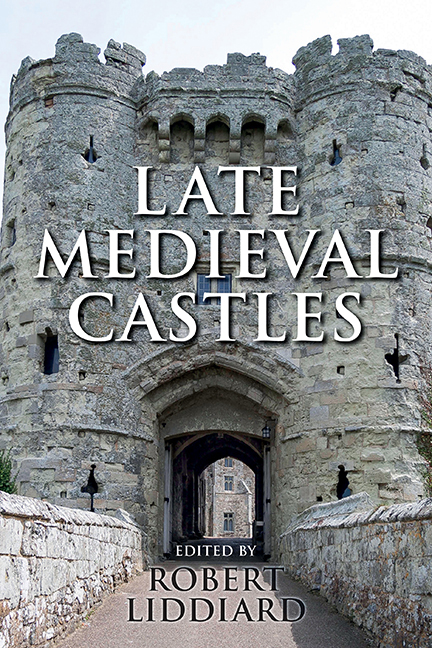Book contents
- Frontmatter
- Contents
- List of Illustrations
- Acknowledgements
- Editor's Preface
- List of Abbreviations
- A Note on the Text
- Introduction
- 1 Fourteenth-Century Castles in Context: Apotheosis or Decline?
- 2 Architects, Advisors and Design at Edward I's Castles in Wales
- 3 The Courtyard and the Tower: Contexts and Symbols in the Development of Late Medieval Great Houses
- 4 Castle Planning in the Fourteenth Century
- 5 Meaningful Constructions: Spatial and Functional Analysis of Medieval Buildings
- 6 Mota, Aula et Turris: The Manor-Houses of the Anglo-Scottish Border
- 7 Lulworth Castle, Dorset
- 8 A Scottish Problem with Castles
- 9 Structural Symbolism in Medieval Castle Architecture
- 10 Specimens of Freedom to Crenellate by Licence
- 11 Some Analysis of the Castle of Bodiam, East Sussex
- 12 English Castles in the Reign Of Edward II
- 13 Castles of Ward and the Changing Pattern of Border Conflict in Ireland
- 14 The Donjon Of Knaresborough: The Castle As Theatre
- 15 The Architecture of Arthurian Enthusiasm: Castle Symbolism in the Reigns of Edward I and his Successors
- 16 Medieval Ornamental Landscapes
- 17 Otherworld Castles in Middle English Arthurian Romance
- Guide to Further Reading
- Index
6 - Mota, Aula et Turris: The Manor-Houses of the Anglo-Scottish Border
Published online by Cambridge University Press: 29 April 2017
- Frontmatter
- Contents
- List of Illustrations
- Acknowledgements
- Editor's Preface
- List of Abbreviations
- A Note on the Text
- Introduction
- 1 Fourteenth-Century Castles in Context: Apotheosis or Decline?
- 2 Architects, Advisors and Design at Edward I's Castles in Wales
- 3 The Courtyard and the Tower: Contexts and Symbols in the Development of Late Medieval Great Houses
- 4 Castle Planning in the Fourteenth Century
- 5 Meaningful Constructions: Spatial and Functional Analysis of Medieval Buildings
- 6 Mota, Aula et Turris: The Manor-Houses of the Anglo-Scottish Border
- 7 Lulworth Castle, Dorset
- 8 A Scottish Problem with Castles
- 9 Structural Symbolism in Medieval Castle Architecture
- 10 Specimens of Freedom to Crenellate by Licence
- 11 Some Analysis of the Castle of Bodiam, East Sussex
- 12 English Castles in the Reign Of Edward II
- 13 Castles of Ward and the Changing Pattern of Border Conflict in Ireland
- 14 The Donjon Of Knaresborough: The Castle As Theatre
- 15 The Architecture of Arthurian Enthusiasm: Castle Symbolism in the Reigns of Edward I and his Successors
- 16 Medieval Ornamental Landscapes
- 17 Otherworld Castles in Middle English Arthurian Romance
- Guide to Further Reading
- Index
Summary
This paper surveys the seigneurial buildings of the Anglo-Scottish Border, and places the fortified buildings constructed between the eleventh century and the seventeenth century in their social and economic context. It shows that the development of these houses was a complex pattern in which the builders responded to changing needs of politics and lordship, which ended in a breakdown of the local feudal society in the late Middle Ages.
The Anglo-Scottish Border is an area famous for its castles, an area in which private fortifications abound, and in which, it has been said, ‘nearly all men of any wealth at all occupied bastle-houses’, that is to say, fortified farmhouses. The common picture of the society and its architecture is one in which the rough and conservative North preserved Norman or even earlier habits to the end of the Middle Ages. The types of buildings, too, are seen as backward-looking: the towers of the fourteenth century and later which are so distinctive a feature of the area were based on Norman keeps: ‘By this time [1386] the days of castle building in England were virtually over … by this time the castle has yielded pride of place to the mansion house. But in the North of England, along the Scottish border where warlike conditions persisted, the old Norman tradition of a square keep or tower-house was never forgotten.’ Even Allen Brown followed this line: ‘Northern fortification in the later Middle Ages shows a remarkable conservatism. Etal … is essentially a lesser keep-and-bailey castle after the twelfth-century manner … and Edlingham in Northumberland … consists merely of a simple, walled enclosure with a square keep at one end and perhaps a gatehouse at the other.’ This echoes a view long held by students of the architecture of the Middle Ages, summed up by Hamilton Thompson: ‘The pele-tower may be regarded as a direct survival of the rectangular keep in a simplified form.’ In this military society, therefore, there is for the student little prospect of tracing the progressive changes to be found in southern England: ‘[Yanworth Hall, Westmorland] shows little development from the Norman keeps of a date two hundred years earlier.
- Type
- Chapter
- Information
- Late Medieval Castles , pp. 127 - 156Publisher: Boydell & BrewerPrint publication year: 2016



